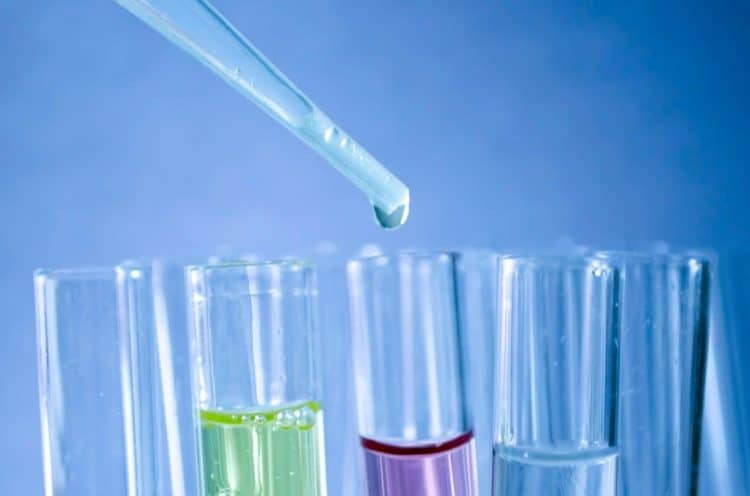QuEChERS is a portmanteau word that blends “Quick, Easy, Cheap, Effective, Rugged, and Safe.” It refers to an extraction-based testing technique introduced in 2003 to quantify pesticide residue on fruits and vegetables. [1] QuEChERS is not only convenient, fast, and cost-effective; it is also applicable to analytes beyond pesticides. As such, its popularity in food testing and other industries exploded. [2,3] In recent years, QuEChERS has gained attention as a viable analytical tool in the burgeoning cannabis industry.
QuEChERS was developed by chemists working for the U.S. Department of Agriculture. [1] The approach consists of four basic steps (with parenthetical details reflecting the original published method) [1-4]
- Single-phase extraction: Homogenize the sample (10 grams [g]) and shake/centrifuge with a solvent (10 mL acetonitrile).
- Liquid-liquid partitioning: Add and mix salts (4 g magnesium sulfate [MgSO4] and 1 g table salt [NaCl]). Water will be ‘salted out,’ meaning its polarity and affinity for the salts will cause it to form an aqueous layer separate from the other compounds and solvent. The solvent layer is collected.
- Dispersive Solid-Phase Extraction (d-SPE): Mix additional salt (150 mg MgSO4) along with solid-phase extraction sorbent (25 mg primary secondary amine [PSA]) and solvent extract (1 ml). This step is known as ‘clean-up’ because it removes residual water and ‘polar matrix components,’ or organic materials that interfere with analysis (e.g., pigments and sugars).
- Gas Chromatography/Mass Spectrometry (GC/MS): Perform quantitative analysis to identify remaining pesticides and other analytes. The original QuEChERS chemists pointed out that 6 samples could be prepared in under 30 minutes at a cost of 1 dollar per sample. [1]
The original method evolved into an approach with modifications depending on the analytes under scrutiny. Different solvents, salts, and buffer additions control the partitioning step, and different sorbents control the clean-up step. [2]
Early studies demonstrated the ability of QuEChERS to detect pesticides in illegal cannabis samples. [5] But widespread legalization and expensive statutory testing requirements mean QuEChERS has a broader and more pressing application for cannabis.
A 2016 experiment in LC GC North America analyzed cannabis edibles and beverages under variable QuEChERS matrices to successfully determine pesticide and cannabinoid content (CBD, CBN, and THC). [6] A 2017 study in the same publication presented a modified QuEChERS method for dried cannabis flower. Researchers used 1.5 grams of sample instead of 10 grams and hydrated the cannabis. They incorporated: 15 ml acetonitrile with 1% acetic acid (solvent with buffer); 6 g MgSO4 and 1.5 g of sodium acetate (salts); and 50 mg PSA, 50 mg carbon-18, and 7.5 mg graphitized carbon black (sorbents). They were able to detect nearly all 160 pesticides inserted into the sample. However, heat and acid sensitivity allowed certain pesticides to evade detection. [7]
This evasion reflects a significant limitation of the QuEChERS approach to cannabis analysis: changing salts, buffers, and organic materials affects recovery of different pesticides. QuEChERS also does not remove terpenes and cannabinoids, which are interfering matrix compounds that bind to the solvent. [8] With continued innovation, however, QuEChERS could become the optimal method for analyzing cannabis in a way that is quick, easy, cheap, effective, rugged, and safe.
References:
- Anastassiades, Michelangelo, et al. “Fast and Easy Multiresidue Method Employing Acetonitrile Extraction/Partitioning and ‘Dispersive Solid-Phase Extraction’ for the Determination of Pesticide Residues in Produce.” Journal of AOAC International, vol. 86, no. 2, 2003, pp. 412–31. Journal Impact Factor = 1.12, Times Cited = 113 (PubMed)
- Rejczak, Tomasz, and Tomasz Tuzimski. “A Review of Recent Developments and Trends in the QuEChERS Sample Preparation Approach.” Open Chemistry, vol. 13, no. 1, 2015, doi:10.1515/chem-2015-0109. Journal Impact Factor = 1.425, Times Cited = 65 (ResearchGate)
- Perestrelo, Rosa, et al. “QuEChERS – Fundamentals, Relevant Improvements, Applications and Future Trends.” Analytica Chimica Acta, vol. 1070, Sept. 2019, pp. 1–28, doi:10.1016/j.aca.2019.02.036. Journal Impact Factor = 5.123
- Lehotay, Steven, et al. “The QuEChERs Revolution.” LC GC Europe, vol. 23, 2010. Journal Impact Factor = 0.47, Cited by = 7 (ResearchGate)
- Schneider, Serge, et al. “Detection of Pesticides in Seized Illegal Cannabis Plants.” Methods, vol. 6, no. 2, 2014, pp. 515–520., doi:10.1039/c3ay40930a. Journal Impact Factor = 2.073, Times Cited = 6 (ResearchGate)
- Wang, Xiaoyan, et al. “Determination of Cannabinoid Content and Pesticide Residues in Cannabis Edibles and Beverages.” LC GC North America: Special Issues, vol. 34, no. 10, pp. 20-27. Journal Impact Factor = 0.16
- Kowalski, Julie, et al. “Evaluation of Modified QuEChERS for Pesticide Analysis in Cannabis.” LC GC North America: Special Issues, vol. 35, no. 5, pp. 8-22. Journal Impact Factor = 0.16
- Craven, Caley B., et al. “Pesticides and Trace Elements in Cannabis: Analytical and Environmental Challenges and Opportunities.” Journal of Environmental Sciences, vol. 85, 2019, pp. 82–93, doi:https://doi.org/10.1016/j.jes.2019.04.028. Journal Impact Factor = 3.120












